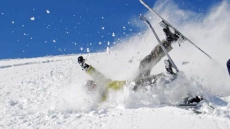VANCOUVER — A man seeking bail while awaiting the possibility of a new trial had a "she is leaving me motive" to kill his common-law wife in British Columbia in 1994 and his confession to an undercover officer should stand, a Crown counsel says.
Hank Reiner told a B.C. Supreme Court judge on Wednesday that Wade Skiffington was angry and jealous and feared he would lose his spouse and his young son before shooting her six times, at an apartment in Richmond.
Reiner said a supposed crime boss did not threaten Skiffington, whose confession about killing Wanda Martin was recorded on a hidden video camera and shown at the bail hearing.
The couple had moved from Newfoundland and Labrador and Martin had wanted to return there before the murder, Reiner said.
Skiffington is being defended by lawyers from Innocence Canada, which works to exonerate people believed to be wrongly convicted. They maintain police used a so-called Mr. Big operation to coerce a confession that was not credible.
Their client was found guilty of second-degree murder in 2001 and is serving a life sentence.
Last year, Innocence Canada asked the federal Justice Department to review the conviction, which is ongoing, while it helps Skiffington apply for bail in hopes the case goes to the B.C. Court of Appeal and a new trial is ordered.
Reiner said that while defence lawyer Philip Campbell argued his client would not have lied to the fictitious crime boss who used violence as an intimidation tactic, the evidence shows Skiffington was repeatedly caught lying to the head of the fake criminal gang that recruited him.
"To Mr. Big, he vacillated between saying he was innocent, he hired a hit man, to again being innocent and to finally confessing. Can anyone seriously argue that Mr. Big would have to express anger and frustration in that context? But no threats were issued."
Reiner said Skiffington's demeanour in the video recording should also be noted, adding he appears to be searching his memory and seems nervous.
"It is a small wonder that Mr. Campbell would like you not to consider demeanour," Reiner told Justice Michael Tammen.
Mr. Big stings typically involve police setting up elaborate scenarios designed to extract confessions from suspects who become part of a crime-group family and are told trust, loyalty and honesty are prized above everything but they must come clean about their past so any incriminating evidence can be destroyed.
A Supreme Court of Canada decision in 2014 involved a Newfoundland and Labrador man convicted of drowning his twin daughters after such a sting by the RCMP.
The top court ruled Nelson Hart's confession to undercover police was inadmissible and two first-degree murder charges against him were withdrawn.
"This case actually bears remarkable similarities to the Hart case," Reiner said.
"The undercover confession is presumptively inadmissible and the trier of fact must look for evidence of corroboration."
Reiner said Skiffington showed a level of awareness and sophistication when he told police in a 1994 interview that he didn't have any gunshot residue and blood on his clothes to link him to Martin murder but later told Mr. Big he'd changed his clothes.
The Crown lawyer also said the trial heard testimony from a couple who said that shortly before Martin's murder, Skiffington staged an assault, saying he'd been mugged and roughed up, in order to get her sympathy so she would stay with him.
The trial heard he and Martin had a rocky relationship, that Skiffington refused to let her take their son back to Newfoundland and Labrador and he was heard calling her degrading names, Reiner said.
He said there was also evidence that Skiffington knew Martin would be alone at her friend's apartment with their son, that he entered from an unlocked door between appointments at his carpet-cleaning job and "fired in blind rage."


